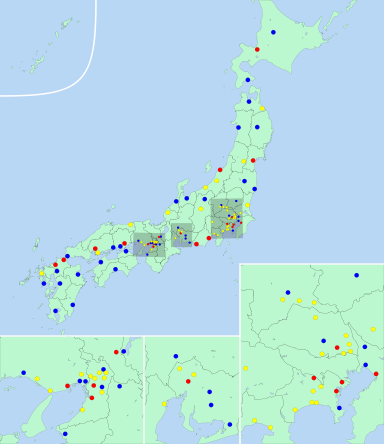- City designated by government ordinance
-
A city designated by government ordinance (政令指定都市 seirei shitei toshi), also known as a designated city (指定都市 shitei toshi) or government ordinance city (政令市 seirei shi), is a Japanese city that has a population greater than 500,000 and has been designated as such by an order of the cabinet of Japan under Article 252, Section 19 of the Local Autonomy Law.
Contents
Overview
Designated cities are delegated many of the functions normally performed by prefectural governments in fields such as public education, social welfare, sanitation, business licensing and urban planning. The city government is generally delegated the various minor administrative functions in each area while the prefectural government retains authority over major decisions. For instance, pharmaceutical retailers and small clinics can be licensed by designated city governments, but pharmacies and hospitals are licensed by prefectural governments.
Designated cities are also required to subdivide themselves into wards (区 ku), each of which has a ward office conducting various administrative functions for the city government, such as koseki and juminhyo resident registration and tax collection. In some cities, ward offices are responsible for business licensing, construction permits and other administrative matters. The structure and authorities of the wards are determined by municipal ordinances.
The 23 special wards of Tokyo are not part of this system, as Tokyo is a prefecture and its wards are effectively independent cities. Although the two largest wards of Tokyo: Setagaya and Nerima, are populous enough to become designated cities, they are not considered to be "cities" within the meaning of the Local Autonomy Law and therefore cannot be designated.
No cities that have been designated by government ordinance have later lost this status.
List of designated cities
Name Japanese Population (2010) Date of designation Region Prefecture # of wards Divisions  Chiba
Chiba千葉 962,130 1992-04-01 Kantō Chiba 6 List  Fukuoka
Fukuoka福岡 1,463,826 1972-04-01 Kyushu Fukuoka 7 List  Hamamatsu
Hamamatsu浜松 800,912 2007-04-01 Chūbu Shizuoka 7 List  Hiroshima
Hiroshima広島 1,174,209 1980-04-01 Chūgoku Hiroshima 8 List  Kawasaki
Kawasaki川崎 1,425,678 1972-04-01 Kantō Kanagawa 7 List  Kitakyūshū
Kitakyūshū北九州 977,288 1963-04-01 Kyushu Fukuoka 7 List  Kobe
Kobe神戸 1,544,873 1956-09-01 Kinki Hyōgo 9 List  Kyoto
Kyoto京都 1,474,473 1956-09-01 Kinki Kyoto 11 List  Nagoya
Nagoya名古屋 2,263,907 1956-09-01 Chūbu Aichi 16 List  Niigata
Niigata新潟 812,192 2007-04-01 Chūbu Niigata 8 List  Okayama
Okayama岡山 709,622 2009-04-01 Chūgoku Okayama 4 List  Osaka
Osaka大阪 2,666,371 1956-09-01 Kinki Osaka 24 List  Sagamihara
Sagamihara相模原 717,561 2010-04-01 Kantō Kanagawa 3 List  Saitama
Saitamaさいたま 1,222,910 2003-04-01 Kantō Saitama 10 List  Sakai
Sakai堺 842,134 2006-04-01 Kinki Osaka 7 List  Sapporo
Sapporo札幌 1,914,434 1972-04-01 Hokkaido Hokkaido 10 List  Sendai
Sendai仙台 1,045,903 1989-04-01 Tōhoku Miyagi 5 List  Shizuoka
Shizuoka静岡 716,328 2005-04-01 Chūbu Shizuoka 3 List  Yokohama
Yokohama横浜 3,689,603 1956-09-01 Kantō Kanagawa 18 List Designated city requirements
Administrative divisions of Japan Prefectural level Prefectures
(都道府県 todōfuken)Subprefectural level Subprefectures
(支庁 shichō)
Municipal level Designated cities
(政令指定都市 seirei-shitei-toshi)
Special cities
(特例市 tokurei-shi)
Special wards (Tokyo)
(特別区 tokubetsu-ku)
Sub-municipal level Wards
(区 ku)- A population greater than 500,000.
Application for designation is made by a city with the approval of both the city and prefectural assemblies.
Scheduled to become a designated city
Region Prefecture Designated City Date of
designationWards Number List Kyushu Kumamoto  Kumamoto 熊本
Kumamoto 熊本1 April 2012 TBD TBD History
The first form of the designated city system was enacted under Japan's first formalized local government system in 1878 with the introduction of "wards." Under this system, wards existed in every city: most cities had only one, but the largest cities at the time — Tokyo, Osaka and Kyoto — were divided into 15, 4 and 2 wards respectively.
The municipal system enacted in 1889 replaced ward assemblies with city assemblies, but retained ward assemblies in Tokyo, Osaka and Kyoto: in these cities, the city had no assembly of its own but was rather governed by the prefectural assembly. In 1898, these cities were allowed to form city assemblies. This ward system was adopted by three more cities prior to World War II: Nagoya (1908), Yokohama (1927) and Kobe (1931). Under a 1911 statute, wards were granted corporate personality and treated as local entities.
Following the war, the 1947 Local Autonomy Law grandfathered in the five subdivided cities (Tokyo having become a prefecture in 1943) as special cities (特別市 tokubetsu shi). This system was replaced by the designated city system when the Local Autonomy Law was amended in 1956.
During the ensuing Japanese economic growth period, the government required designated cities to be forecast to reach a population of 1 million within the near future, but this requirement was dropped in 2005 in order to accommodate several geographically large cities formed by mergers under the Koizumi government.
References
External links
- Text of the Local Government Law (Japanese)
Metropolitan cities of Japan Tokyo Metropolis Designated cities Core cities Akita · Amagasaki · Aomori · Asahikawa · Fukuyama · Funabashi · Gifu · Hakodate · Higashiōsaka · Himeji · Iwaki · Kagoshima · Kanazawa · Kashiwa · Kawagoe · Kōchi · Kōriyama · Kumamoto · Kurashiki · Kurume · Maebashi · Matsuyama · Miyazaki · Morioka · Nagano · Nagasaki · Nara · Nishinomiya · Ōita · Okazaki · Ōtsu · Shimonoseki · Takamatsu · Takasaki · Takatsuki · Toyama · Toyohashi · Toyota · Utsunomiya · Wakayama · YokosukaSpecial cities Akashi · Atsugi · Chigasaki · Fuji · Fukui · Hachinohe · Hirakata · Hiratsuka · Ibaraki · Ichinomiya · Isesaki · Jōetsu · Kakogawa · Kasugai · Kasukabe · Kawaguchi · Kishiwada · Kōfu · Koshigaya · Kumagaya · Kure · Matsumoto · Mito · Nagaoka · Neyagawa · Numazu · Odawara · Ōta · Sasebo · Sōka · Suita · Takarazuka · Tokorozawa · Tottori · Toyonaka · Tsukuba · Yamagata · Yamato · Yao · YokkaichiPrefectural capitals
(not included above)Categories:- Subdivisions of Japan
- Cities in Japan
- Japanese law
Wikimedia Foundation. 2010.


